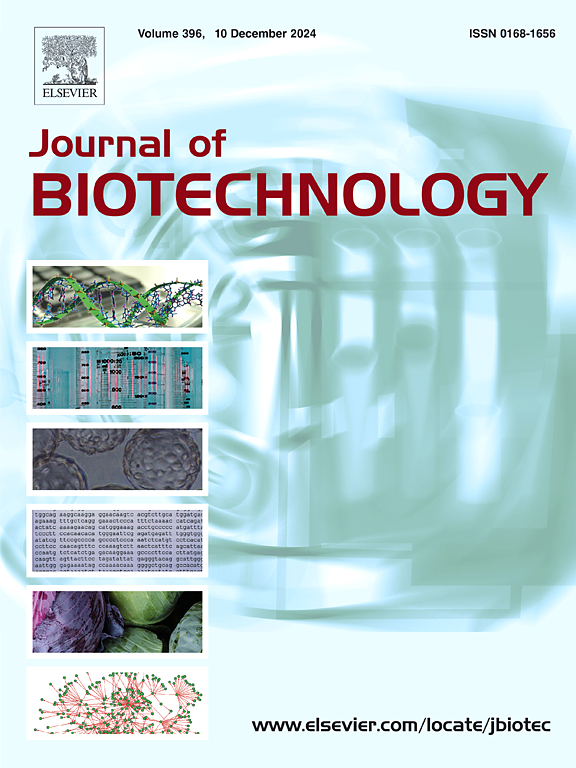嗜热和中温蓝藻热降解动力学及c -藻蓝蛋白的纯化。
IF 4.1
2区 生物学
Q2 BIOTECHNOLOGY & APPLIED MICROBIOLOGY
引用次数: 0
摘要
天然蓝色着色剂c -藻蓝蛋白(C-PC)有许多潜在的应用,但其热稳定性差限制了其商业应用。本研究比较了两种蓝藻:嗜热的热聚球菌TUBT-T01和嗜热的蜡状聚球菌TISTR8589的C-PC产量和热稳定性。热聚球菌产生的C-PC几乎是塞德勒姆球菌的1.9倍。采用色谱阳离子交换树脂(Streamline Direct HST1)批量吸附法对C-PC进行了有效的纯化。树脂对C-PC的平衡吸附量(Qeq)在pH为5时最高。在这个pH下,嗜热的C-PC的Qeq是5.5±0.1mg - 1,而嗜温的C-PC的Qeq是1.5±0.2mg - 1。纯化后,嗜热C-PC浓度提高5.9倍,中温C-PC浓度提高4.2倍。两种蓝藻的最终产物纯度比相似,为~2.2。在60℃和pH 7条件下,热聚球菌C- pc的半衰期比中温性C- pc长约12倍;然而,由于热聚球菌的生物量生产力较低,嗜热性C-PC的生产力相对较低。本文章由计算机程序翻译,如有差异,请以英文原文为准。
Thermal degradation kinetics and purification of C-phycocyanin from thermophilic and mesophilic cyanobacteria
The natural blue colorant C-phycocyanin (C-PC) has many potential applications but its poor heat stability limits its commercial use. This study compares the production and thermal stability of C-PC from two cyanobacteria: the thermophilic Thermosynechococcus sp. TUBT-T01 and the mesophilic Synechococcus cedrorum TISTR8589. Thermosynechococcus sp. produced nearly 1.9-fold more C-PC than S. cedrorum. Batch adsorption using a chromatographic cationic ion exchange resin (Streamline Direct HST1) was used to effectively purify the C-PC. The equilibrium adsorption capacity (Qeq) of the resin for C-PC was the highest at pH 5. At this pH, the Qeq for the thermophilic C-PC was 5.5 ± 0.1 mg mL⁻¹ , whereas for the mesophilic C-PC it was 1.5 ± 0.2 mg mL⁻¹ . Purification increased the concentration of the thermophilic C-PC by 5.9-fold, and that of mesophilic C-PC by 4.2-fold. The purity ratios of the final products from the two cyanobacteria were similar at ∼2.2. At 60 °C and pH 7, the C-PC of Thermosynechococcus sp. had ∼12-times longer half-life than the mesophilic C-PC; however, the productivity of the thermophilic C-PC was comparatively low because of a low biomass productivity of Thermosynechococcus sp.
求助全文
通过发布文献求助,成功后即可免费获取论文全文。
去求助
来源期刊

Journal of biotechnology
工程技术-生物工程与应用微生物
CiteScore
8.90
自引率
2.40%
发文量
190
审稿时长
45 days
期刊介绍:
The Journal of Biotechnology has an open access mirror journal, the Journal of Biotechnology: X, sharing the same aims and scope, editorial team, submission system and rigorous peer review.
The Journal provides a medium for the rapid publication of both full-length articles and short communications on novel and innovative aspects of biotechnology. The Journal will accept papers ranging from genetic or molecular biological positions to those covering biochemical, chemical or bioprocess engineering aspects as well as computer application of new software concepts, provided that in each case the material is directly relevant to biotechnological systems. Papers presenting information of a multidisciplinary nature that would not be suitable for publication in a journal devoted to a single discipline, are particularly welcome.
 求助内容:
求助内容: 应助结果提醒方式:
应助结果提醒方式:


